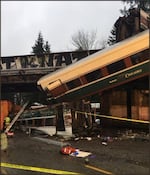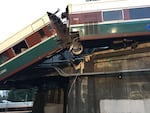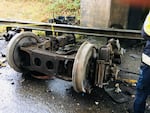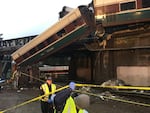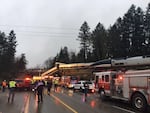
A Portland-bound Amtrak train derailed near Tacoma, Wash., Monday, Dec. 18, 2017.
Pierce County Sheriff's Department
UPDATE (Tuesday, 3:24 a.m. PST) – The Amtrak train that derailed Monday morning was advertised as traveling along a faster new route, but two miles before the curve where the train came off its track was a warning: the speed dropped to 30 mph.
National Transportation Safety Board said late Monday that the derailed train was, according to a preliminary investigation, going 80 miles an hour before it came off the tracks.
Safety board member Bella Dinh-Zarr said it's unclear why the train was traveling so fast or whether the crew knew of the speed limit. Monday morning marked the first trip along a new route for Amtrak's Seattle-to-Portland trains.
The maximum speed limit for some of the train’s route reached up to 79 miles per hour, according to Kimberly Reason, a spokeswoman with Sound Transit.
Related: Amtrak Train Hurtles Off Overpass; At Least 3 People Killed
Sound Transit owns the curve of track where train derailed, and confirmed the 30 mph limit. Speed signs are posted two miles before the speed zone and right before the curve, Reason said.
Some witnesses remarked on its speed.
Daniel Konzelman, who was traveling parallel to the train and heading southbound on Interstate 5, told The Seattle Times he was driving at 60 miles per hour and watched the train pass his vehicle shortly before the crash.
Chris Karnes, who is the chair of Pierce Transit’s advisory board, sent a tweet Monday morning from the train: “Wow this train is fast. Once you leave downtown Tacoma it’s 79 m.p.h. to Portland. We are passing up traffic on I-5.”
Wow this train is fast. Once you leave Downtown Tacoma it's 79mph to Portland. We are passing up traffic on I-5.
— Chris Karnes 🌹🌎🚈 (@TacomaTransit) December 18, 2017
The train was making its inaugural run along the route when it came crashing off an overpass south of Tacoma early Monday.
The crash killed at least three people. Seventy-seven passengers and five crew members were on board when it derailed, according to reporting from the Associated Press. At least 50 people were hospitalized.
Christine Kilduff is a state lawmaker who represents the community where the train derailed. It’s the second Amtrak train to go off the tracks in her district within the last year.
She says the derailments raise real safety concerns.
Amtrak Train Derailment Location
The Amtrak train derailment on Dec. 18 occurred close to where the new Cascades route reconnects to the original route.
Data: US Dept. of Transportation, Open Street Maps, Amtrak / OPB
Kilduff said she believes the state should have more control over the trains that travel through the state.
“When accidents like this happen and tragedies like this happen — there is a local impact,” she said. “We have a number of people dead. We have people who have been severely injured. We have the closure of Interstate 5."
In many cases, federal law preempts state law when it comes to regulating train traffic.
Following a 2008 head-on crash between two trains in Los Angeles, Congress required all major rail lines to implement what's known as a "positive train control" system as part of an effort to prevent, among other things, derailments caused by high speeds. Positive train control systems track trains via GPS and can activate a train's brakes if it exceeds local speed limits.
Amtrak president Richard Anderson told Fox News that the stretch where Monday's crash occurred does not have positive train control in place. Despite the congressional mandate, implementation of positive train control and other safety improvements has lagged because of the high price tag.
This story has been updated.
